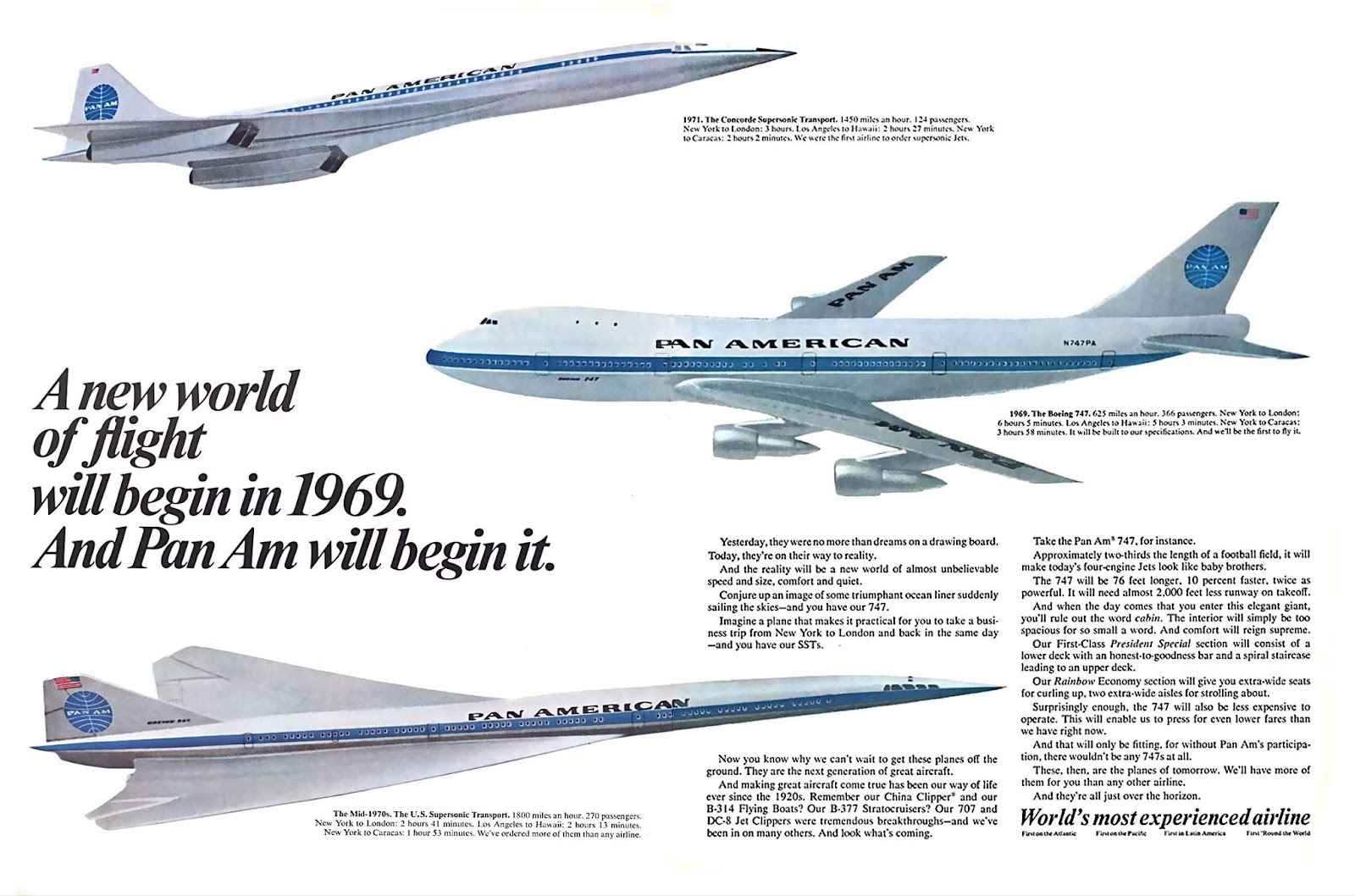Sign up for Big Think on Substack
The most surprising and impactful new stories delivered to your inbox every week, for free.
The Apollo program and Concorde airliner are remembered as two of humanity’s most amazing technological successes: putting a man on the Moon and flying passengers at twice the speed of sound. Both hit their key milestones in 1969, remarkably born out of an era of slide rules, drafting paper, and wind tunnels.
In 1969, the future of aerospace certainly looked bright. Almost everyone expected a future of mainstream supersonic travel. A 1969 NASA report proposed a Moon base and a manned mission to Mars within 15 years.
Yet, the actual history is far darker. Supersonic flight was stillborn, with just 14 Concordes ever entering service. And the Moon landing marked a literal high point in space exploration. Private astronaut Jared Isaacman and his crews hold the record for farthest distance traveled from Earth since the end of the Apollo era — and their 870 miles is a far cry from the 239,000 miles to the Moon.
This is a stunning reversal of technological progress, perhaps unlike any since the Dark Ages. Would the most pessimistic person in 1969 have predicted that in 2025, we would no longer be sending people to the Moon or flying passengers faster than the speed of sound?
Glory is a dangerous goal, and when it is pursued without regard to pragmatic utility, much damage is done.
Concorde and Apollo did not produce the better future we expected. For a staunch advocate of human progress, I believe a heresy: both Concorde and Apollo were mistakes; we would have been better off without them.
These programs share a common origin: a Cold War-era desire in the West to demonstrate technological superiority over the Soviet Union. Apollo was, of course, championed at the highest levels of the U.S. government and consumed 4% of the federal budget at its peak. Concorde was a joint venture between the French and British governments, established via treaty in 1962.
Both programs ultimately delivered tech demos — and both threw off technologies that might otherwise have taken longer to invent — but neither paved a path toward an enduring future of space exploration or supersonic travel. Both pursued glory without regard to cost or practicality.
Glory is a dangerous goal, and when it is pursued without regard to pragmatic utility, much damage is done.
Ironically, in our desire to show the superiority of the West over Soviet central planning, the West adopted centrally planned big aerospace projects. And it didn’t work out for the West any better than it did for the Soviets.
Concorde’s fatal flaw
Before the 1960s, every major new commercial airplane was developed with a market in mind. The Douglas Aircraft Company built the DC-3 because it saw an airplane that passengers would be delighted to buy tickets for at prices that would earn handsome profits for airlines. Similarly, Boeing bet on the 707 — the first commercial jetliner — as it expected to open a new, expanded age of faster travel.
The would-be supersonic age had very different origins. Government-led supersonic projects were started in Soviet Russia, Europe, and America. The Soviet project led to the famously unsuccessful Tupolev Tu-144. In Europe, France and Britain teamed up to create Concorde, and in America, there was the American Supersonic Transport (SST). In each case, the aircraft were spec’d for and funded by governments that cared more about beating each other than about producing economically viable products.
Concorde’s economics never made any sense. It had about 100 seats — twice as many as you’ll find in a 747’s first-class cabin — but the seats were smaller with fares well above first-class (up to $20,000 each in today’s dollars). This basic economic equation never added up, which is why only 14 Concordes ever carried passengers — and why, across their 27 years of operation, the aircraft often flew half empty, even on the popular New York-to-London route.
The American SST would have been an even bigger economic disaster than Concorde. Whereas Concorde promised Mach 2 and 100 seats, the American Federal Aviation Administration (FAA) demanded 300 seats and Mach 3 — threatening an even bigger economic crater. As taxpayers footed the bill for Apollo, they were also paying Boeing to develop the SST — a jet that made no sense to develop unsubsidized.

A Pan Am ad from 1969 featuring Concorde.
These airplanes ignored what every businessperson knows instinctively: the higher the price, the fewer the takers. Supersonic should have started small, with a 5- to 10-seat business jet designed to carry the most well-heeled passengers coast to coast. Indeed, entrepreneurs in the 1970s were working on just such an airplane.
Over budget and behind schedule, Congress rightly pulled the plug on the SST. Boeing rapidly canceled the project, which made no sense to pursue unsubsidized. Yet, Concorde was still coming, with Europe paying for its development. In 1973, the U.S. banned supersonic flight over land, ostensibly due to noise, but arguably because, with Boeing’s supersonic subsidy cut, it seemed supersonic was a threat to the American aerospace hegemony.
That decision didn’t just kill Concorde, it killed the product that would have launched the supersonic age: the small supersonic business jet. Had the supersonic business jet come first — an executive aircraft with coast-to-coast range — it could have built a thriving market and kicked off an innovation cycle that would have led to progressively faster and larger airplanes. We might all be going Mach 5 by now. If you can’t fly supersonic over the continental U.S., there is no meaningful market for a supersonic executive jet. Those pursuing it went bankrupt.
With the political dynamics of Concorde leading to the ban of supersonic flight in the U.S., and with Concorde’s economic failure, industry drew the wrong conclusion that supersonic flight inherently made no economic sense. The result was half a century of stasis in commercial flight — and a gradual exodus of the most ambitious talent out of America’s previously great aerospace companies.
History’s greatest tech demo: Apollo
Apollo’s failure was subtler, but ultimately even more damaging. It inspired millions, advanced materials and control systems, and proved what human ingenuity can do under pressure. But it also created a bureaucratic and cultural trap that held back space progress for 50 years.
When President John F. Kennedy declared, “We choose to go to the Moon,” he was launching another government-specified tech demo: an all-out sprint to beat the Soviets. The result was spectacular but unsustainable. Every decision was optimized for one purpose: a single victory. Once achieved, the political momentum evaporated, leaving behind a sprawling bureaucracy built to perpetuate itself and a supply chain drunk on lucrative cost-plus contracting with no sense of economics or efficiency.

President John F. Kennedy delivering his famous speech, “Address at Rice University on the Nation’s Space Effort,” in 1962. Credit: NASA
NASA’s post-Apollo decades were dominated by the institutional inertia Apollo created. Instead of lean, iterative innovation, we got a cost-insensitive supply chain and a risk-averse culture more interested in preserving itself than in delivering sustainable economic value. The Space Shuttle, marketed as “routine spaceflight,” ended up costing $1.5 billion per launch in today’s dollars. The cost per kilogram to orbit barely improved from Apollo, and the launch cadence slowed.
It wasn’t until SpaceX, a private company operating outside the NASA procurement model, that launch costs dropped by an order of magnitude. The Falcon 9’s reusable first stage accomplished what NASA’s vast budget couldn’t: meaningful, enduring progress. And SpaceX found that it couldn’t rely at all on the slow, bloated, and extraordinarily inefficient legacy aerospace supply chain and wasteful defense contracting Apollo left in its wake.
High-priced tech demos don’t build the future
There’s an important distinction to be made between government as customer and government as spec writer.
When the government acts as a demanding but rational buyer — especially for military-relevant tech — it can catalyze innovation. World War II production — built on the back of commercial industry — was certainly a resounding success. DARPA funding helped seed the internet, driven by a real need for resilient communications. But when the government dictates specs for civil projects — pouring in billions without market discipline — the result is often a monumental prototype that can’t evolve into a viable product, and a vast wreckage of a supply chain unsuited to competitive commercial endeavors.
That’s what Concorde and Apollo both were: proof-of-concept demonstrations of what’s possible technologically, detached from market economics. Their very success blinded policymakers and engineers alike to the deeper challenge: creating a sustainable, iterative path to make the technology affordable, repeatable, and scalable.
Real progress happens through customer-driven iteration, not exhibition. The Wright brothers’ Flyer begat the DC-3, which begat the 707. Each step was an incremental advance grounded in commercial reality. Concorde broke this trend — and the consequence was a half-century of no progress in the speed of flight.
Progress needs economic pressure, not bureaucratic pressure.
The real tragedy of Concorde and Apollo is that they convinced generations that progress was something governments demonstrate, not something societies build.
The right lesson from Concorde wasn’t “supersonic is too hard.” It was “supersonic needs market-driven innovation.” The right lesson from Apollo wasn’t “we’ve conquered space.” It was “we’ve just begun.” But instead of doubling down on affordable, scalable progress, both fields were frozen, their myths preserved while their industries stagnated.
By contrast, look at what happens when we align innovation with markets. SpaceX, Blue Origin, and Rocket Lab are lowering the cost to reach orbit by 20x. In aviation, private efforts like my company, Boom Supersonic, are reviving high-speed flight with modern materials, efficient engines, and digital design tools — and, most importantly, an airplane that makes economic sense, with initial fares a quarter of what was charged on Concorde, delivered in a form factor that will be highly profitable to commercial airlines.
Progress needs economic pressure, not bureaucratic pressure. The next great leap will come not from government showpieces, but from disciplined, iterative engineering aimed at real markets and real people.
When innovation is reborn under entrepreneurial leadership, progress becomes self-sustaining again.
Just as the death of space exploration and supersonic flight shared a common cause — unlimited budgets and government-led tech demos — their rebirth shares a common engine: the return of entrepreneur-led innovation.
When private founders, not committees, set the vision, constraints become creative fuel.
SpaceX succeeded where NASA stagnated, not because it had more money, but because it had far less and had to make every dollar count. Iteration replaced bureaucracy. The result wasn’t just a cheaper rocket; it was the rebirth of orbital progress after 50 years of stasis.
The same dynamic is playing out in supersonic flight. Boom is doing what Concorde couldn’t precisely because we’re doing it differently. We’re building for a market, not a political mandate. The goal isn’t to prove what’s possible once, but to make it possible for everyone — affordably, sustainably, and at scale.
When innovation is reborn under entrepreneurial leadership, progress becomes self-sustaining again. Space is opening. Supersonic is returning. And for the first time in decades, the future is accelerating.
Sign up for Big Think on Substack
The most surprising and impactful new stories delivered to your inbox every week, for free.

